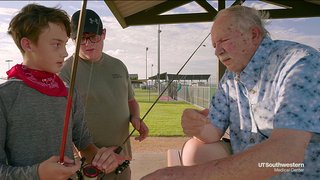Robotic bronchoscopy offers minimally invasive, earlier lung cancer diagnosis
May 4, 2022

Lung cancer screening and imaging has improved significantly over the years, leading to earlier detection of disease and fewer-cancer related deaths. Approximately 1.5-2 million new pulmonary nodules (spots and related abnormalities on imaging) are detected every year in the United States, and these nodules often require further evaluation.
Bronchoscopy, CT-guided biopsies, and surgical sampling are options for diagnosis of such abnormalities. Each sampling approach has its own advantages, disadvantages, and potential complications. Thus, a significant challenge remains – how to biopsy suspicious abnormalities detected on chest imaging, especially those deep within the lungs, and using minimally invasive techniques.
Robotic bronchoscopy is an innovative technology we’re using to overcome such challenges. Paired with advanced 3D reconstruction of imaging, this minimally invasive procedure allows us to navigate an ultra-thin and very flexible tube with a camera on the end of it into the lungs to pinpoint suspicious lesions. The increased dexterity of the steerable tube makes it possible to safely reach areas in the lungs we couldn’t access before.

Prior to the availability of this robotic approach, pulmonologists would operate the bronchoscope with one hand and use their other hand to perform the diagnostic procedure like sampling. The robotic arm on this new technology, which we operate from a separate console, allows more complex movements and steerability, and frees up both the pulmonologist’s hands to perform the biopsy without open surgery.
UT Southwestern’s Interventional Pulmonology team was the first in the DFW metroplex, and one of the earlier institutions in the country, to offer this robotic technology. UTSW also combines robotic bronchoscopy with advanced imaging techniques – such as intra-procedure cone beam CT imaging, segmented fluoroscopy, radial endobronchial ultrasound, and linear endobronchial ultrasound – to diagnose abnormalities in standard and hard-to-reach regions of the lung.
This approach is rapidly becoming the new standard of care at UT Southwestern, providing patients with earlier diagnoses and streamlining their path to safe, efficient, and accurate treatment.
Who is a candidate for robotic bronchoscopy?
Once we assess a patient’s chest X-ray and CT imaging, we determine if a biopsy is needed. Then we choose the best modality based on the patient’s health, imaging characteristics, and location of the lesion. Every patient is unique and our multidisciplinary team – made up of specialists from interventional pulmonology, interventional radiology, thoracic surgery, medical oncology, radiation oncology, and other services – decides together which technique would be the best approach for each patient.

If the lesion is close to the surface of the lung and easy to reach by CT-guided biopsy, bronchoscopy likely would not be needed. Our interventional radiology team can use a needle guided by a CT scan to biopsy the lesion. The diagnostic yield of this modality is impressive at more than 90%, but it does carry with it a risk (10-25%) of pneumothorax – an air leak into the space between the lungs and chest wall.
Robotic bronchoscopy may be the best option for lesions deeper in the lung, near a major blood vessel, or near a portion of diseased lung. The robotic approach could also be beneficial for patients who have other health concerns, such as severe lung disease or active smoking, which could increase the risk of infection or other rare complications associated with other biopsy options.
UT Southwestern is continuing to gather data on the diagnostic yield and safety of robotic bronchoscopy. We are conducting both retrospective and prospective studies utilizing this technology combined with advanced intra-procedure imaging guidance. So far and after the initial 250 procedures, it has proven to be a safe and valuable tool for sampling suspicious lung lesions.
Related reading: Should I be screened for incidental pulmonary nodules?
What to expect during a robotic bronchoscopy
During a traditional bronchoscopy, we place a bronchoscope – a thin flexible tube with a light and camera on the end of it – in the patient’s mouth or nose, down their throat or through an anesthesia tube, and into their airways. The pulmonologist holds the scope with one hand while using the other to perform the biopsy or other diagnostic or therapeutic interventions.
With robotic bronchoscopy, we use the Intuitive robotic-assisted ION platform featuring a robotic arm and a separate controller platform to control and guide a robotic arm and ultrathin steerable catheter. The arm holds and maneuvers the ultra-thin, ultra-flexible scope into the lung, freeing up the pulmonologist’s hands to perform the biopsy and allowing for greater dexterity and maneuverability to manage difficult angles in narrow airways that extend deep into the lungs.
The robotic controller features a roller ball to change directions and a rolling knob to advance or retract the steerable catheter scope. The system provides stability during sampling of the lesions and alerts us if there is tension on the scope or if it presses against the patient’s lung tissue.
Additionally, we use advanced 3D imaging tools to show the position of the scope and confirm that the lesion has been accessed in real time. These combined technologies – robotic assisted bronchoscopy with cone beam CT, segmented fluoroscopy, and endobronchial ultrasound – allow us to precisely and accurately reach suspicious lesions. As we are sampling, we have a pathologist in the room who can review slides made from our biopsies to ensure we are getting adequate tissue that will lead to an accurate diagnosis.
Robotic bronchoscopy is done under general anesthesia and takes about one to two hours. The vast majority of patients can go home the same day, with some soreness or numbness in the mouth and throat. Results from the biopsy generally are available within several days.
The future of robotic bronchoscopy
We started performing robotic bronchoscopies in early 2021, and our team has done more than 250 of these procedures to date. As an early adopter of robotic bronchoscopy, we are doing retrospective and prospective research to refine the procedure and share our experience with the medical community.
While our initial focus is on using robotic bronchoscopy for diagnostic purposes, we’re also optimistic about the technology’s future role in early treatment, such as bronchoscopic tumor ablation – applying precise doses of radiofrequency energy, heat, cold or radiation to destroy a lung tumor from inside the body, without the need for external approaches or incisions.
Early diagnosis and treatment can dramatically improve lung cancer outcomes, and robotic-assisted bronchoscopy is evolving into an approach that will allow us to offer more patients a safe, streamlined, timely treatment and earlier, advanced lung care.
To find out whether you or a loved one might benefit from robotic bronchoscopy, call 214-645-8300 or request an appointment online.











